Fiorentini opened its doors in Rutherford, NJ less than two years ago. In that short time, the humble restaurant—tastefully decorated with foliage and natural wood tables—has garnered a robust resume of praise. Chef Antonio De Ieso, along with wife Brenda De Ieso and Sous Chef Kevin Conover, have crafted one of NJ’s best dining experiences since the get-go. So, when I heard about Antonio and Conover unveiling their new Blind Tasting at the Chef’s Table, I was intrigued. I knew Fiorentini already comfortably stood out against 95 percent of New Jersey restaurants, but the addition of a Chef’s Tasting could change the whole game. Chef Antonio traces back to his Tuscan roots, aiming to make you feel as if you are in his home and while the food excels beyond your average home-cooked meal, the stories and casual conversation offer a uniquely intimate feel that is unavailable in traditional dining.
It was make or break for Fiorentini. It falls short, and Antonio risks his food diving into obscurity. On the flip side, if Fiorentini’s blind tasting was sublime, then it could propel itself even higher amongst Jersey’s best, maybe even to wider recognition.
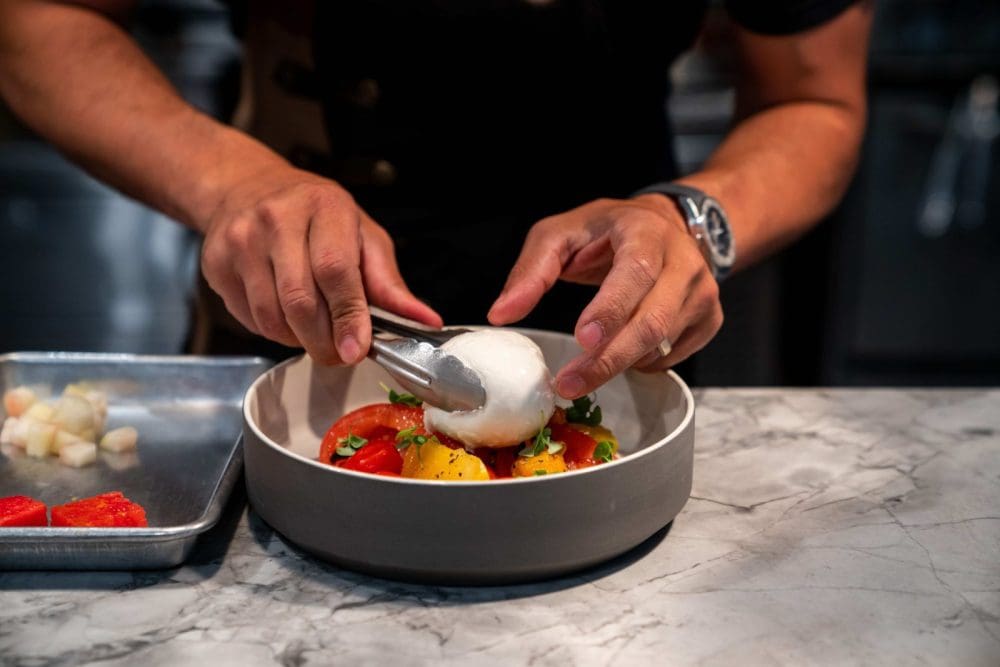
Photo by Arielle Figueredo
For those unfamiliar with De Ieso’s career, he has worked in several kitchens, throughout several countries, across several continents. The man is by all means a world traveler when it comes to his work. And though his food primarily focuses on his home country of Italy—and Florence to be even more specific—you can find inspiration from De Ieso’s illustrious career throughout his entire menu. At only 36 years old, impressive is an understatement when it comes to describing Chef Antonio De Ieso.
But, again, I had to ask myself: Would the blind tasting hold up to his à la carte offerings at Fiorentini? Would this dining experience fall short, souring my picture-perfect view of Fiorentini as a restaurant? These were all valid questions, and questions that deserved answers.
There was only one real way to answer them. So, I booked the Chef’s Table and made my way over to Fiorentini.
Arrival
Upon arriving, I sat down at the white, marble countertop that has become somewhat of a centerpiece for Fiorentini. Doubling as the kitchen pass, it was understood that dishes for the dining room would be sliding across the counter throughout my meal. Meaning that in addition to getting a front-row seat to my own meal, I also had the pleasure of reveling in the magic of an à la carte dinner service, complete with the aromas and sounds of the kitchen.
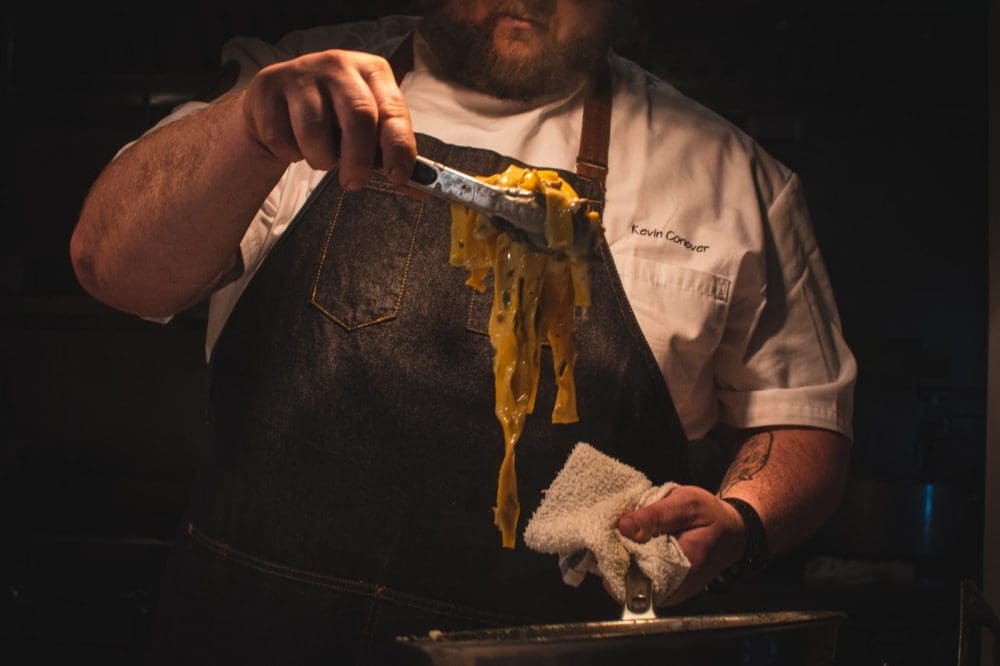
Sous Chef Kevin Conover plates pasta | Photo by @emmagaribianphoto
For me, the sight of a well-run kitchen is one of the most entertaining shows in the world. Forget sports or concerts, this is where I get my kicks, and unless you’ve done it before, it is nearly impossible to understand the pure dedication and focus that goes into this line of work. Sitting at the Chef’s Table allows you to see this firsthand, it also allows for guests to see two wildly different styles of dining side by side: Fast-paced à la carte service, and the wonderful slow burn of a tasting experience.
Dinner runs anywhere from eight to ten courses and takes place over several hours. In just a couple hours, you experience a full house of hungry diners to being the last guest in the house. We would even be treated to the sight of the kitchen being cleaned—something Antonio described as intentional. “We spend so much time perfecting what we do, why try to hide any of it?”
Course One: Bread and Butter
The first course promptly arrived, a simple bread and butter. Tuscan bread and house-made seeded crackers were placed in a wooden dish with a sidecar of freshly-churned butter. The butter was finished with a healthy dosing of sea salt. Antonio takes an ingredient as simple as farm-fresh cream and creates something delicious out of it, setting the tone for the meal to follow. The butter was silky and fresh, while crunchy flakes of salt provided a burst of salinity, accentuating the flavors of the cream. The bread and crackers were there as a vehicle to deliver butter to my palate, but on their own, they held up—an often overlooked detail.
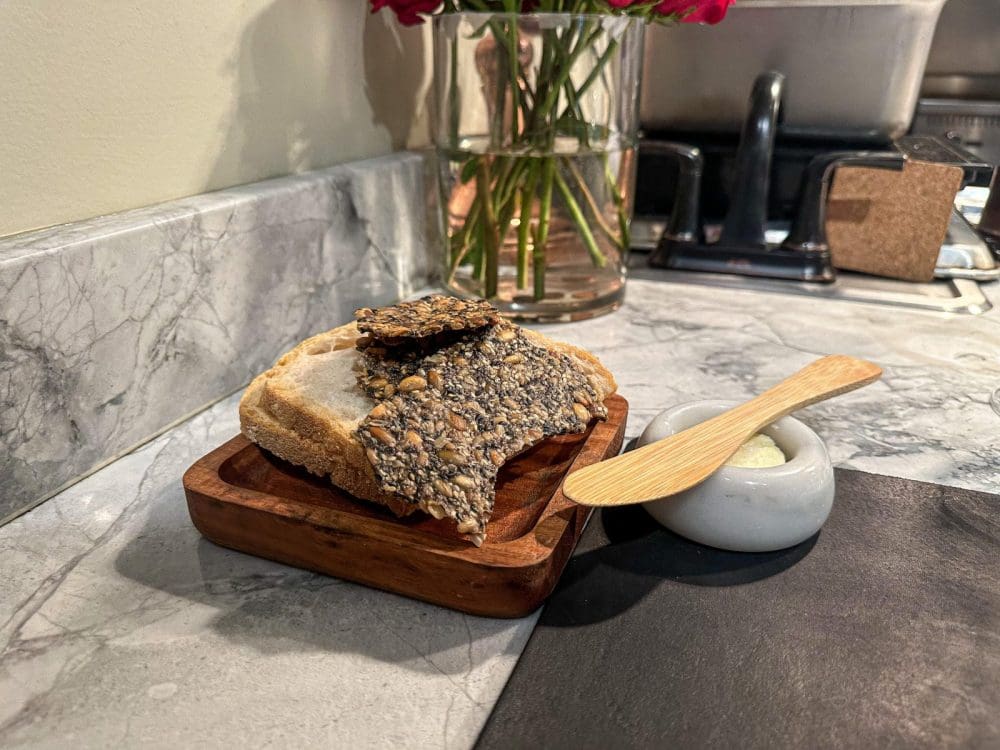
Tuscan Bread, Seeded Crackers, Fresh Butter
Course Two: Cauliflower Cannoli
Then, amuse bouche. Antonio piped an earth-toned puree into a crispy, cylindrical shell made of phyllo. Adorning the top of the bite was a roasted piece of flowering cauliflower—also known as fioretto. Antonio described it as a “cauliflower cannoli,” the filling being a purée of roasted cauliflower, emulsified with extra virgin olive oil. Atop it, the roasted fioretto was seasoned with a touch of lemon and vinegar. It was a one-biter, so I picked it up with my fingers and followed suit. The shell shattered as soon as it hit my teeth, and I was immediately met with an explosion of cauliflower flavor. With so few ingredients, Antonio creates a bite of food that is complex well beyond its parts. Furthermore, he hammers in the idea that Fiorentini as a whole centers around: Food is best when it’s left to bask in its simplicity.
The time Antonio takes to talk to guests between bites is intimate and eye-opening, and it’s part of what makes the Chef’s Table at Fiorentini so special. I find so often that meals of this caliber can be rushed, so Antonio’s particular attention to a well-paced experience was tasteful. Within these discussions I was given an inside look on how Antonio conjures up flavors and concepts. He treated me as if I was a guest in his home and I began to think about the experience as such.
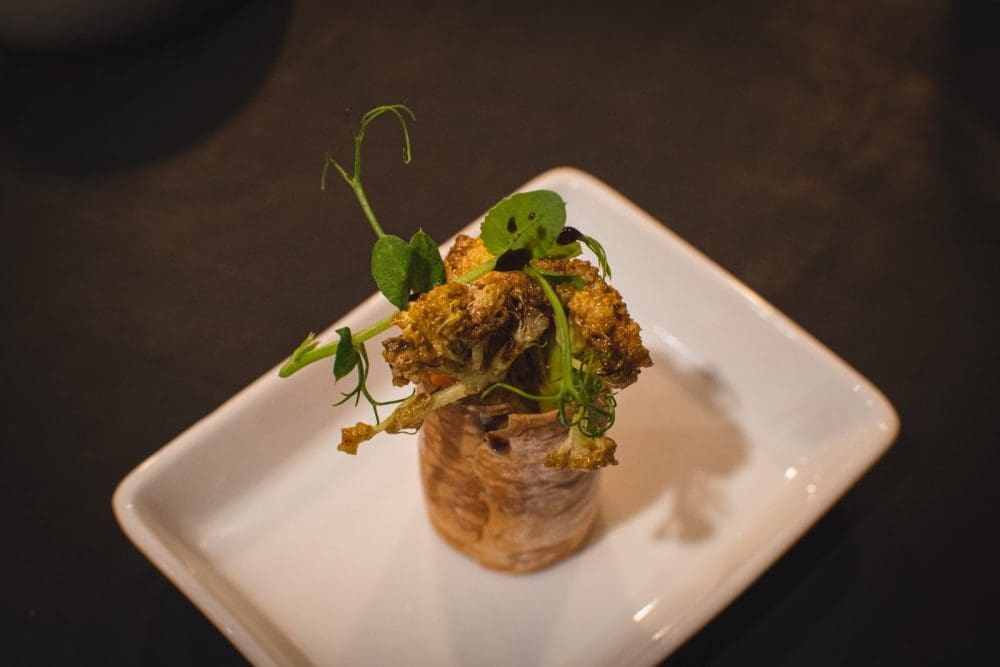
Cauliflower Cannoli | Photo by @emmagaribianphoto
Course Three: Smoked Duck and Orange
While talking, Antonio layered slices of pink-hued meat onto a white plate. He began to explain the course: Smoked duck breast with orange marmalade on toast, tarragon aioli, and a foam made of sheep’s milk cheese. The dish was finished with carefully placed onion flowers, serving as a functional garnish. The meat was rich, with a deep, smoky flavor almost reminiscent of pastrami. That richness was the perfect pair for the orange marmalade which was made in the traditional manner by boiling oranges—skin and all—with sugar and water. The pectin in the orange’s skin acts as a thickening agent, allowing the mixture to seize up when cooled into a spreadable, jelly-like consistency. The dish is bursting with flavor, hitting each note as needed. Salty from the duck and cheese foam, sweet and acidic from the marmalade on brioche, and of course, herbaceousness from the aioli. It was a practically perfect third course, though I do feel the dish could have used a touch less of the foam as the funky taste clouded some of the more delicate flavors of the dish.
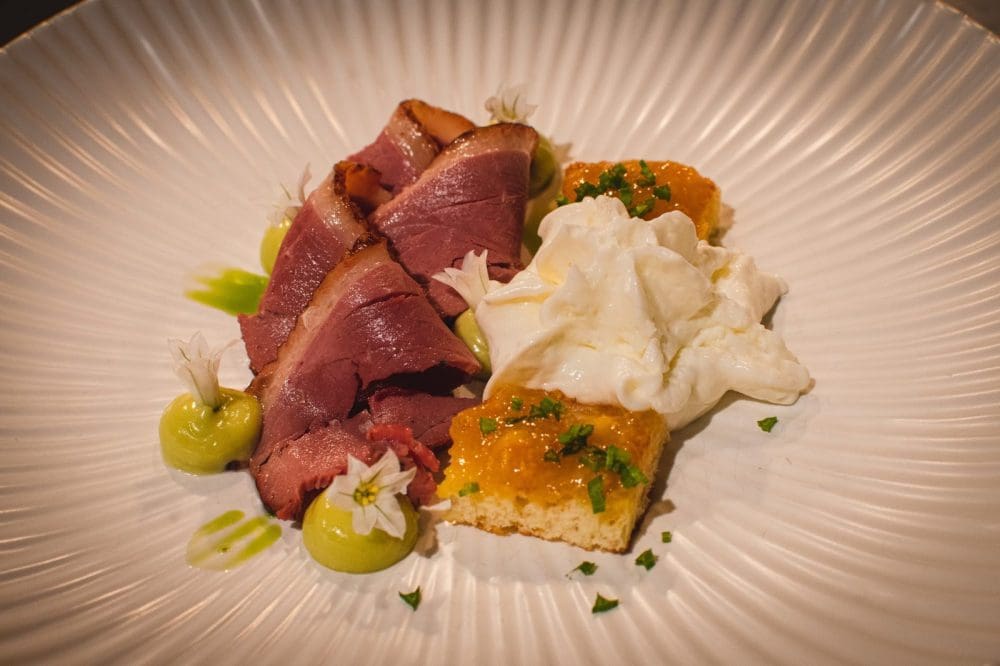
Smoked Duck and Orange | Photo by @emmagaribianphoto
Course Four: Carbonara Tortelli
Something remarkable went down as we were finishing up the last bites of smoked duck. Antonio pulled out a wooden board with rolled sheets of pasta on it and began filling pasta in front of me. The filling was deeply yellow with specks of black and mahogany. Antonio explained that the next bite of food would be a carbonara tortelli. I let out an almost audible sigh as every carbonara inspired pasta I have ever had has fallen well short of the real thing. But this was no ordinary carbonara-filled pasta—and Antonio De Ieso is certainly no ordinary chef.
After filling the pasta à la minute, the tortelli was boiled and lightly sauced in butter. Antonio plated one tortelli on a plate without a garnish and slid it in front of me. This was, without a doubt, the plainest looking dish Antonio has ever put out. But, this dish wasn’t about aesthetics at all. “Close your eyes,” Antonio told me, “and take a bite.” I did as ordered and suddenly, it all made sense. The once-thick filling thinned out inside the pasta as it cooked, exploding as you bite it. It sauces the pasta around it, tasting and feeling exactly like your classic spaghetti carbonara. “What does it taste like?” Antonio asked me, laughing as he already knew the answer.
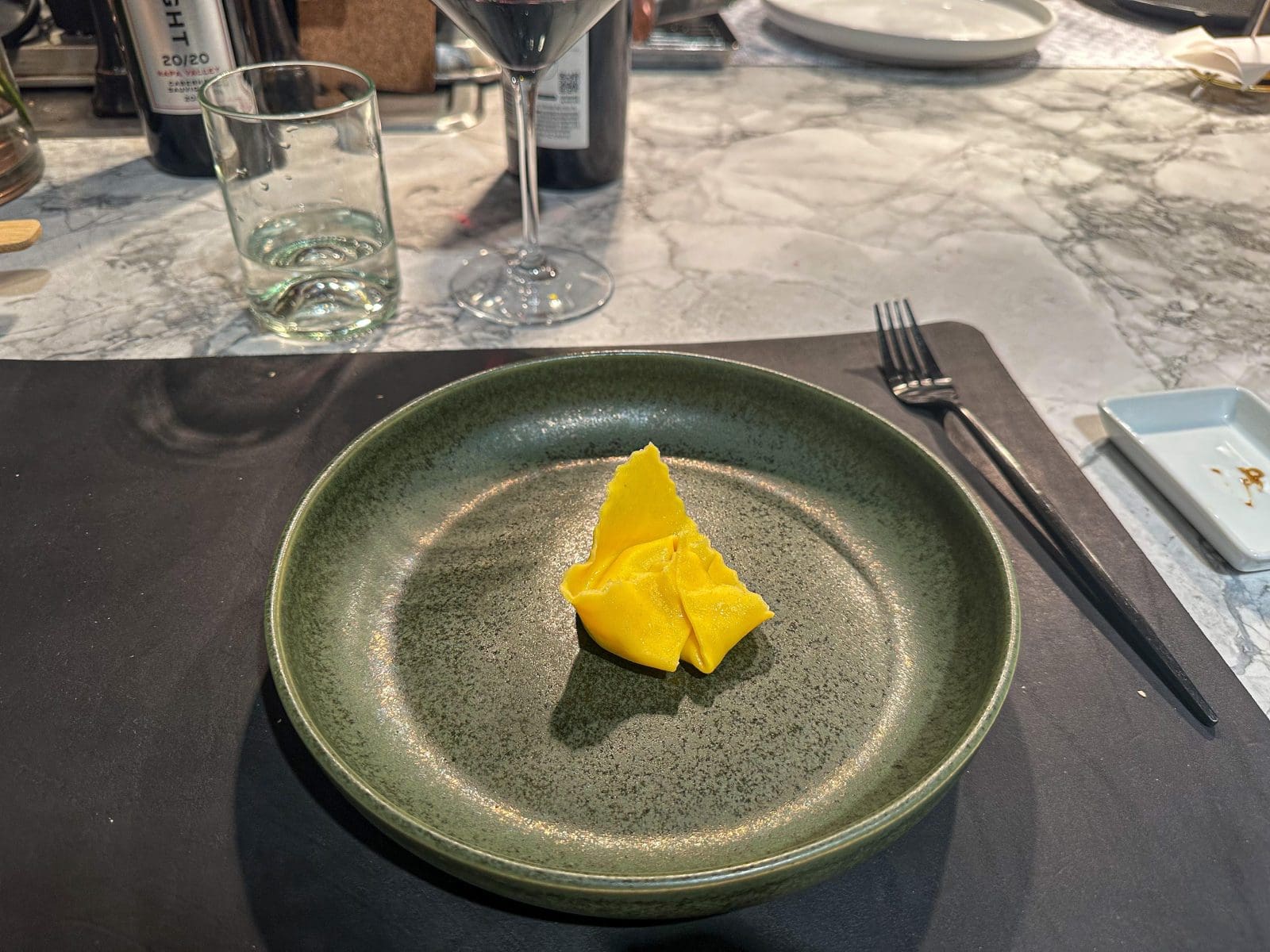
Carbonara Tortelli—No Garnish
By this point, I was perplexed. I’ve had some pretty mind-blowing bites in my day, but to plate something so plainly, knowing it will hold up takes a level of confidence not seen in many chefs. Antonio’s carbonara tortelli should win awards, I’d put it toe-to-toe with the best pastas across the nation.
Course Five: Pea Fagottini with Lobster and Crab
De Ieso and Conover followed the tortelli with another filled pasta, keeping their foot steadily on the gas. Two filled pastas in a row was bold, but I was more than ready to indulge. Spring pea fagottini was the course. The pea-filled pyramids of pasta were green and yellow on the outside, with a light green filling on the interior consisting of sweet peas and mascarpone. Surrounding the bundles of pasta was a light saucing of lobster and crab bisque, pea tendrils and dots of lump crab meat. While the torteli before it was paradoxical, this was straightforwardly delicious. The luscious bisque was the perfect pairing for the fresh taste of in-season peas. Each component was exceptional on its own, but elevated in conjunction with one another.
Again, Antonio astounded me with pasta, something that won’t surprise anyone who has dined at Fiorentini before. But, for me, what was so impressive was the certitude Antonio had in his own cooking. Two filled pastas in a row could have been a massive blunder. If one falls short, it’s a failure. Additionally, if they are too similar in makeup, you risk palate fatigue—the mortal enemy of a tasting experience. Instead, I was treated to two remarkably special bites of pasta, each phenomenal in their own way.
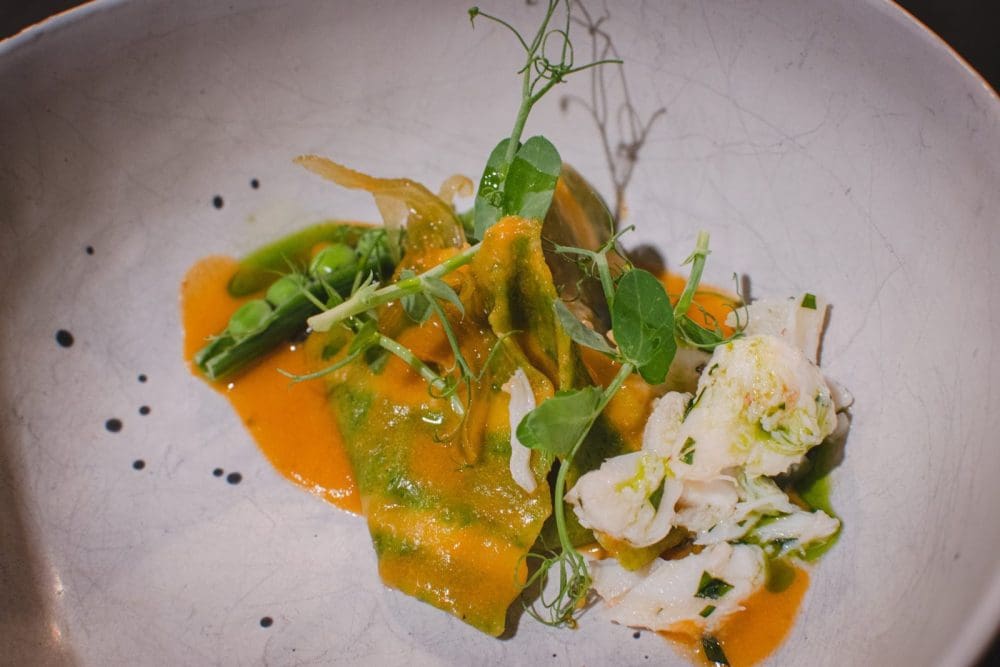
Sweet Pea Fagottini | Photo by @emmagaribianphoto
Course Six: Scallops with Guanciale
Three scallop shells appeared on the pass and Conover began spooning a mixture of peas, asparagus and guanciale into them. A bright green herb butter was poured into it, the small diced vegetables and pork jowl studding the liquid like gems. Atop, a perfectly seared Point Pleasant scallop was delicately placed and immediately slid in front of me. A properly cooked scallop is something special—its meat is sweet and plump while holding onto a tender and delicate chew. The addition of the guanciale into this dish was the game-changer, though. The spring vegetables and scallop being soft in flavor provided the perfect match for the salty funk of a good guanciale. When the scallop was gone, I promptly picked up the shell and drank the butter, making sure not to leave any peas or pork behind. All things considered, this was one of the better scallops I have had in recent memory.
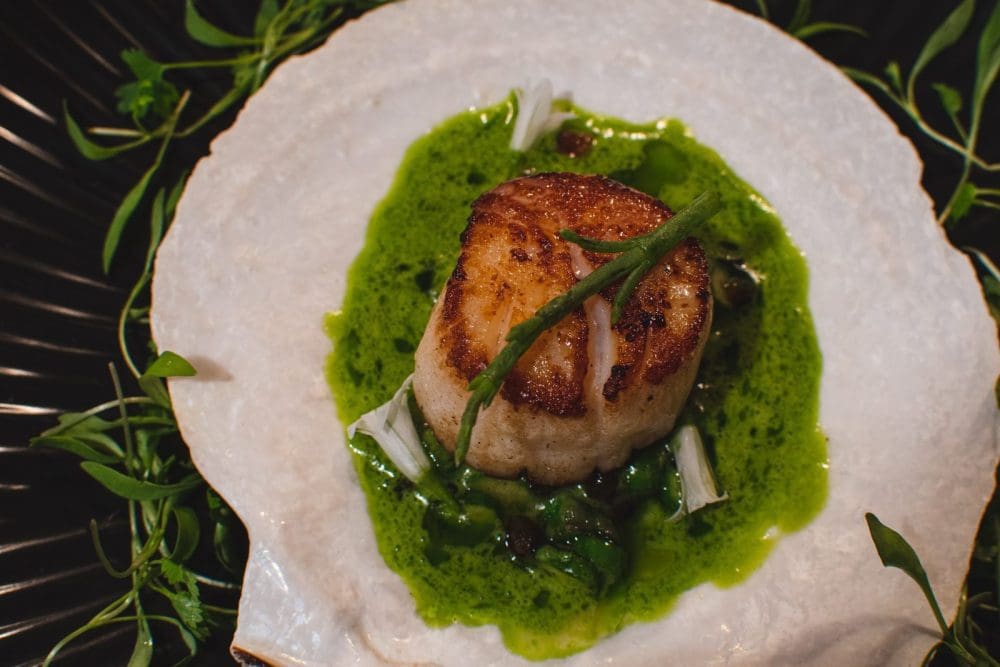
Point Pleasant Scallop | Photo by @emmagaribianphoto
Course Seven: Lamb with Spring Vegetables
I then saw Antonio walking over to the pass with a tray of lamb chops, glistening with a mixture of rendered lamb fat and butter. As they finished resting, he smeared a bright green ramp purée onto a taupe-colored plate. Beside it, he spooned a circle of what he referred to as a “pea tartare,” along with a brûléed shallot and lastly, the lamb chop. The lamb itself sported a deep mahogany crust with a tepid, wall-to-wall, medium rare interior. Antonio pointed out the cooking method used for the lamb, which consisted of searing off the sides before basting in butter until the butter caramelized into beurre noisette, AKA, brown butter. The meat is still totally raw at this point and is allowed to finish cooking in the oven. By searing it hard first, a seal is created, allowing the lamb to lock in its own juices and flavors, the butter basting adds both flavor and an opportunity to fill any crevices of the meat that have not achieved a full sear.
Juxtaposed with the rich lamb chop was the fresh and bright tartare. Copious amounts of mint provided a much-needed floral boost to the dish and the ramps and charred shallot offered an allium-forward flavor that complemented the dish’s entirety. To be honest, I generally dislike lamb, but I would gladly eat this iteration again and again.
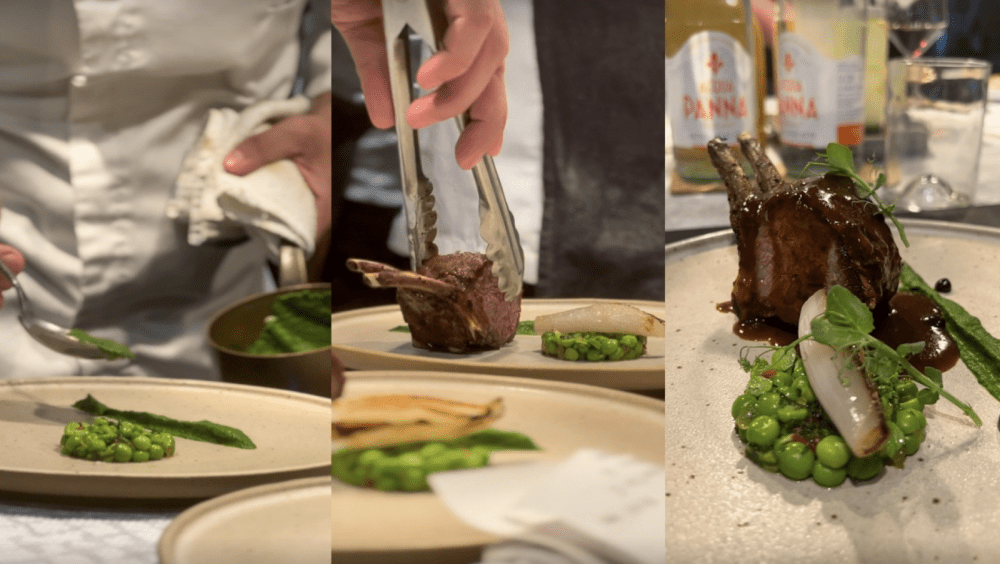
Chef Antonio plates lamb
Course Eight: Porchetta
As I finished the remaining bites of lamb, Antonio was plating the final savory portion of the meal, a magnum opus of sorts for the blind tasting at the Chef’s Table. Porchetta. There perhaps isn’t a word in the universe that gets me more excited than “porchetta” and as the aroma of rendered pork fat and herbs wafted through the air, I was more than ready to dive into Antonio’s version of the classic. “This is Tuscan style,” he laughed while plating up a wedge of the golden-hued meat. To understand my excitement, take a step back and review the porchetta making process.
Antonio takes a whole belly of pork and seasons it with a mixture of salt and herbs he explained as a secret recipe hailing from his grandma. The belly is then rolled around a loin of pork, with the skin wrapping the exterior and is tied off. This large, tube-shaped hunk of pork is then allowed to dry in the fridge for around 48 hours. Once dried, Antonio sears the porchetta off in a hot oven, before dramatically lowering the heat and allowing the inside to delicately cook. If done correctly, the fat renders into a soft chew, the meat remains moist and flavorful and the skin morphs into a crackling-like texture that shatters with a bite.
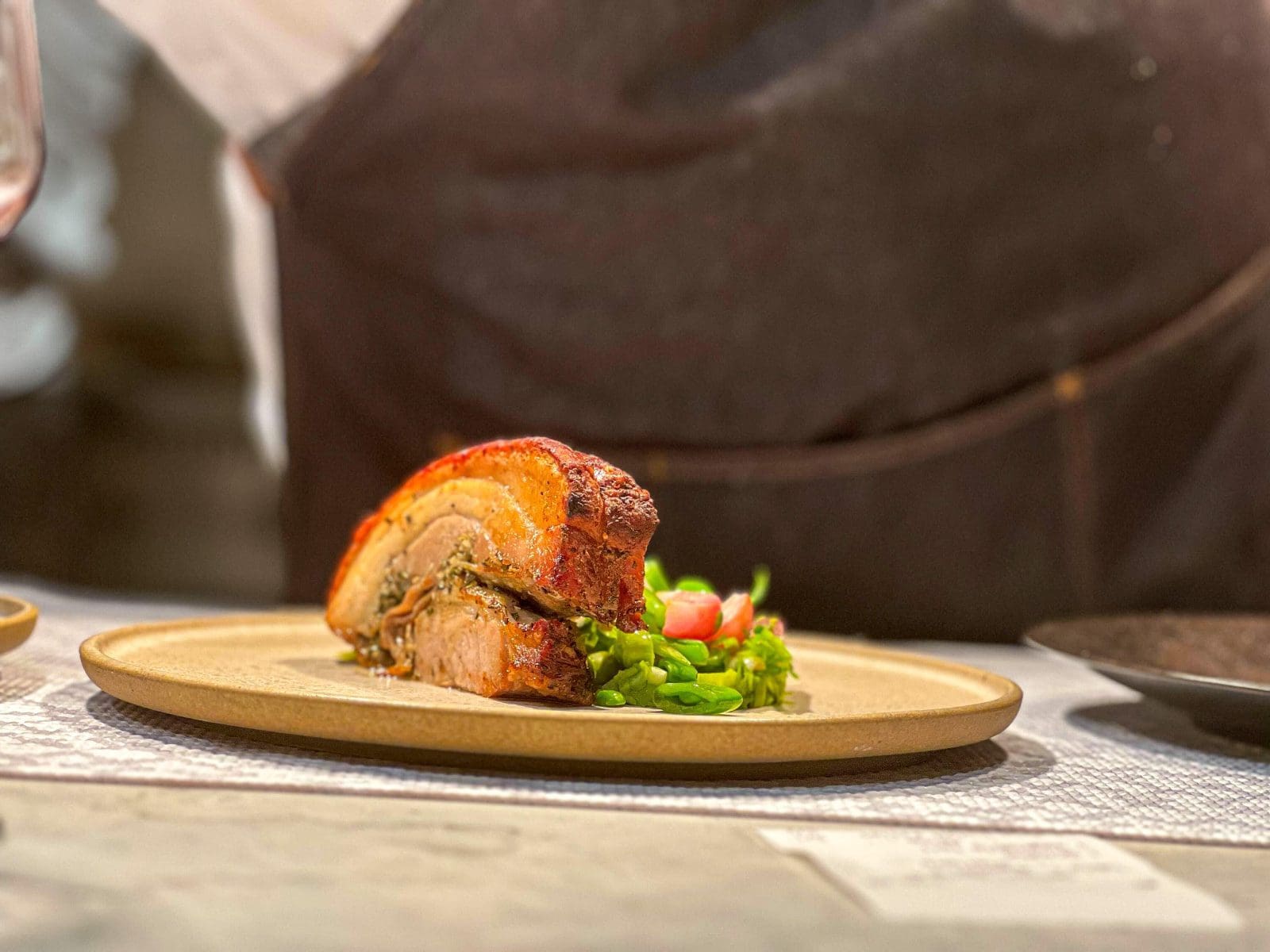
Porchetta
Antonio plated a wedge of porchetta along with an herby salsa verde and a medley of gently-cooked scallions, peas and fresh fava beans. The brightness of the latter two components was an absolute necessity for contrasting the rich and fatty meat, but that meat is where the magic truly lies. The skin was crisp and salty, while the interior was well-seasoned and properly cooked across each subsection of meat. The leaner meat was moist and tender and the fat was pleasant to chew, not undesirable or toothy by any means. While many porchettas are layered with a heavy dosing of fennel pollen—almost to a fault—Antono’s version doesn’t use fennel at all and retains an almost Thanksgiving-esque flavor thanks to the herbs used. This was a memorable bite of food—close your eyes and you’d think you were on the streets of Florence indulging in a Porchetta Panino. This was the perfect way to close out the savory section of the meal.
Course Nine: Sorbetto
Now, over three hours in, my palate was starting to tire. Luckily, Antonio had the perfect cure for my ailment: Sorbetto. House-made raspberry sorbet was scooped into a glass dish and topped with a healthy dosage of 20-year Villa Manodori balsamico. The sorbet was jam-packed with fresh raspberry, which provided the perfect pairing to the rich, syrup-like balsamico. Vinegar like this is rather convoluted, as the lengthy aging process allows more delicate flavors and sweetnesses to develop over time. It possesses a rich aroma and a deep, jet-black color. With only two components, each part needs to be of the highest quality. While the sorbetto is the main event, the Villa Manodori provides harmony, accentuating the flavors as a whole.
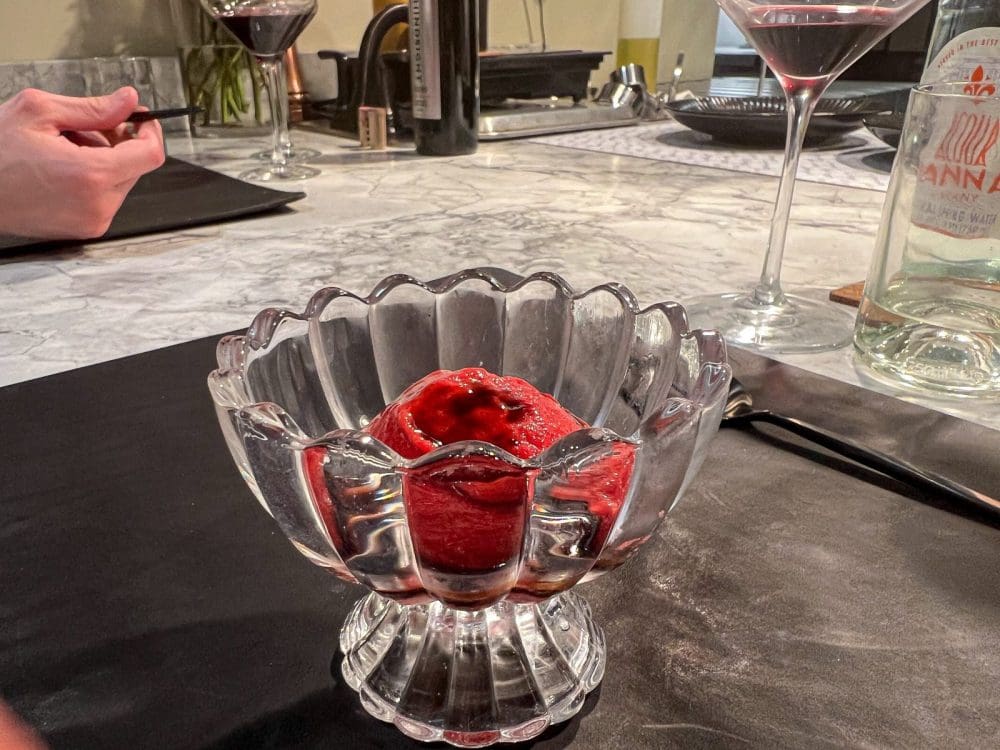
Raspberry Sorbetto with Villa Manodori Balsamico
Course 10: Mousse with Hazelnut and Olive Oil Ice Cream
The final course arrived: Chocolate and white chocolate mousses are combined, along with hazelnut praline, honeycomb, olive oil ice cream and sea salt. This tasted like an elevated Ferrero Rocher, the chocolate mousse and hazelnut pairing up to create one of life’s greatest combinations. Though, the silent star was the olive oil ice cream, which was sweet and fruity with a pleasing crunch from the flaky sea salt that sat atop it. As someone with an immense sweet tooth, I was more than happy to end my meal this way, licking the plate clean to conclude my experience.
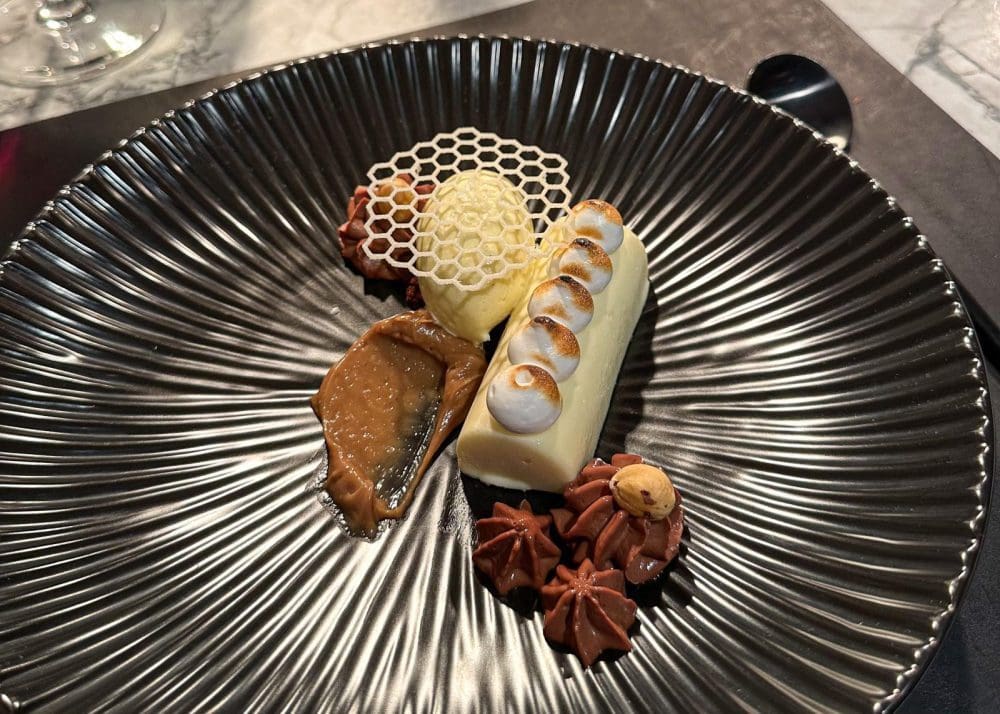
Hazelnut and Mousse
Fiorentini’s blind tasting at the Chef’s Table isn’t your typical dining experience. It is well-priced and lengthy, including many flavors and hyper-seasonal ingredients. This is not something to do on a weekly basis (though it would be nice) and is best when reserved for once in a blue moon.
Antonio De Ieso continues to impress at his Rutherford restaurant, Fiorentini, where along with Brenda De Ieso and Sous Chef Kevin Conover, the three are leading the charge in Rutherford’s ever-growing dining scene. The Chef’s Table only adds to this thought by providing guests with an unforgettable meal in an exquisite setting. While the food is top-notch, what really sets Antonio’s experience apart from similar ones in New Jersey is his commitment to you, the guest. Between each bite, Antonio wants to know what you think—he desires a conversation about his food and will work hard to get it. For a few hours, you aren’t in Fiorentini or Rutherford, but instead in Antonio’s home, eating at his kitchen table. And though the food is well beyond your typical home-cooked fare, the conversations and stories are familiar.
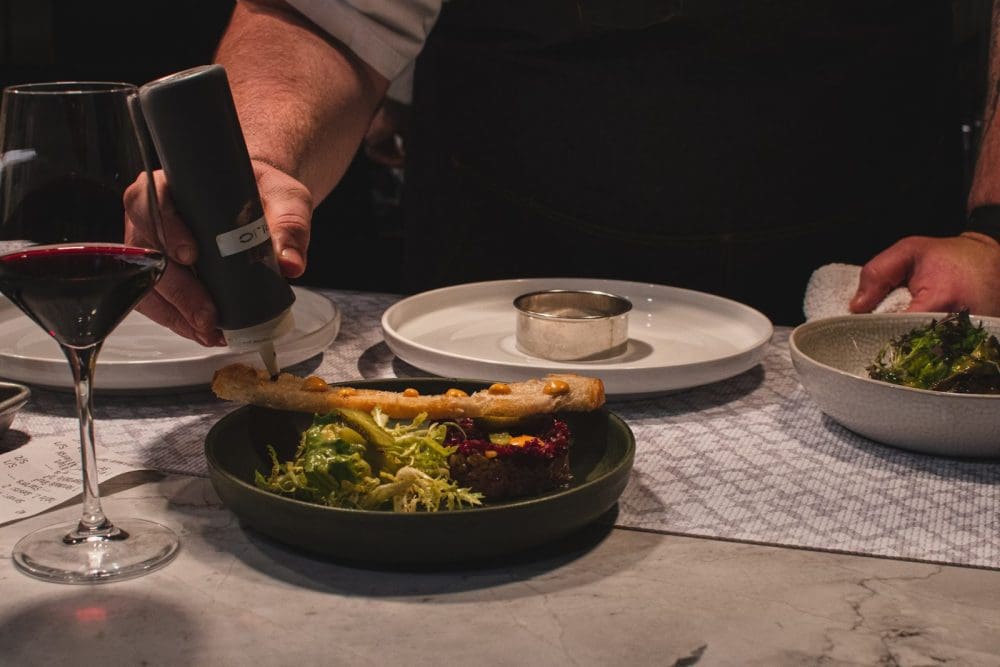
Photo by @emmagaribianphoto
What I especially admired about this dinner was the refusal to use any gimmicks. Chefs love to throw in “adventurous” or expensive ingredients when unnecessary, especially in settings like this. While I love caviar and foie gras, it doesn’t improve everything it touches and oftentimes, even detracts from a dish’s personality. Antonio uses simple ingredients and cooking methods, but the way he orchestrates them is a skill that cannot be taught. It is a natural talent that many chefs work decades to even sniff. But, for Antonio, it’s just another Thursday.
There is nothing left to say that hasn’t already been said of Antonio De Ieso, who, in my opinion, is one of New Jersey’s finest chefs. The blind tasting at the chef’s table only adds to this thought. This is simply one of NJ’s greatest dining experiences.
About the Author/s
Peter Candia is the Food + Drink Editor at New Jersey Digest. A graduate of The Culinary Institute of America, Peter found a passion for writing midway through school and never looked back. He is a former line cook, server and bartender at top-rated restaurants in the tri-state area. In addition to food, Peter enjoys politics, music, sports and anything New Jersey.

1 comment
Great article